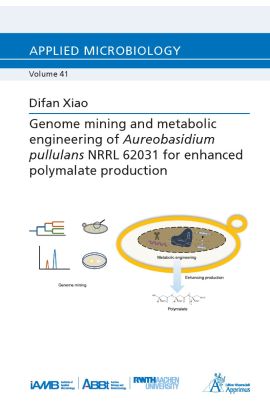Polymalate (PMA) holds considerable promise as a biomaterial for medical applications. The fungus Aureobasidium pullulans NRRL 62031 naturally produces PMA. However, its genomic basis, biosynthetic pathways, metabolic engineering targets, and regulatory elements for enhanced PMA production remain unclear.
This study begins by analyzing the genomic features, key enzyme-encoding genes, and biosynthetic gene clusters (BGCs) involved in PMA biosynthesis and its regulation.
The second aim is to identify the gene responsible for PMA polymerization in A. pullulans NRRL 62031. Alignment searches and gene knockout experiments confirmed a core synthetic gene within a non-ribosomal peptide synthetase-like BGC as essential for PMA biosynthesis.
The third goal is to elucidate the main pathway for malate synthesis, the PMA precursor. Gene knockout strategies and metabolic inhibitor feeding experiments indicated that malate is primarily derived from the reductive TCA pathway.
Overexpression of the pyruvate carboxylase-encoding gene increased PMA titer by 18%. Additionally, disruption of polyol lipid synthesis, fatty acid formation, and removal of a putative PMA hydrolase increased titer by 31%, 22%, 12%, respectively.
The final objective is to investigate regulatory elements affecting PMA production. Replacing the native upstream region of the PMA synthetase gene in A. pullulans NRRL 62031 with a conserved upstream region from high-producing strains unexpectedly reduced PMA production. Comparative genomic analysis suggested that protein modification genes uniquely enriched in A. pullulans NRRL 62031 may promote PMA degradation, thereby limiting its production.
Bioinformatics analysis identified transcription factors (TFs) likely to bind the upstream region of the PMA synthetase gene. Deletion mutants were used to assess their roles in PMA production. Notably, deletion of the calcineurin-responsive TF Crz1 boosted PMA titer but reduced cell biomass. In contrast, deletion of Msn2 and CreA decreased PMA production and altered physiology. A combined knockout of FAS1/2 related to fatty acid synthesis and CRZ1 achieved the highest PMA titer in this study.
These findings offer valuable insights into the biosynthetic pathway of PMA and effective metabolic engineering strategies to enhance its production. They establish a solid foundation for the sustainable and efficient bioproduction of PMA in A. pullulans, accelerating its application across various biotechnological fields.
| Autor | Xiao, Difan |
|---|---|
| Gewicht | 0.345 kg |
| Erscheinungsdatum | 24.06.2025 |
Institut für Angewandte Mikrobiologie (iAMB)
Genome Minnig and metabolic Engineering of Aureobasidium pullulans NRRL 62031 for enhanced polymalate production
Kurzbeschreibung
Polymalate (PMA), a promising drug delivery system, can be produced by Aureobasidium pullulans NRRL 62031. The key genetic determinant for PMA polymerization and the primary pathway for malate synthesis were identified. Four gene knockout targets and one overexpression target were found to enhance PMA titer. Genetic insights into PMA hydrolysis were also obtained through bioinformatics. This study lays the foundation for the large-scale production of PMA and its medical applications.

